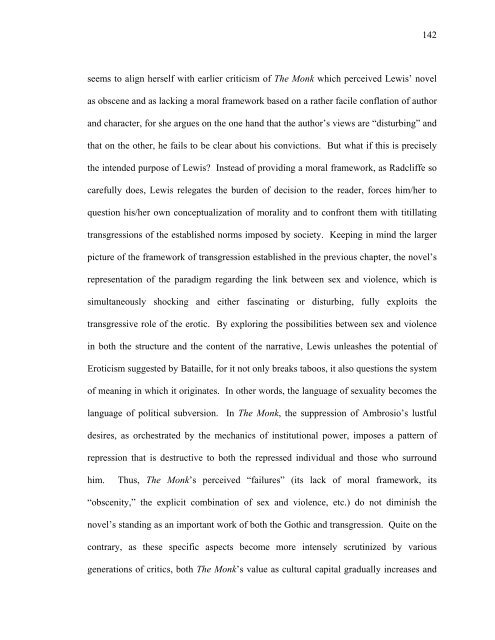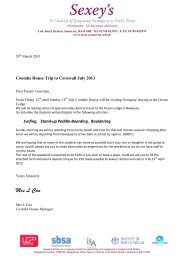Untitled - Sexey's School Moodle
Untitled - Sexey's School Moodle
Untitled - Sexey's School Moodle
Create successful ePaper yourself
Turn your PDF publications into a flip-book with our unique Google optimized e-Paper software.
seems to align herself with earlier criticism of The Monk which perceived Lewis’ novel<br />
as obscene and as lacking a moral framework based on a rather facile conflation of author<br />
and character, for she argues on the one hand that the author’s views are “disturbing” and<br />
that on the other, he fails to be clear about his convictions. But what if this is precisely<br />
the intended purpose of Lewis? Instead of providing a moral framework, as Radcliffe so<br />
carefully does, Lewis relegates the burden of decision to the reader, forces him/her to<br />
question his/her own conceptualization of morality and to confront them with titillating<br />
transgressions of the established norms imposed by society. Keeping in mind the larger<br />
picture of the framework of transgression established in the previous chapter, the novel’s<br />
representation of the paradigm regarding the link between sex and violence, which is<br />
simultaneously shocking and either fascinating or disturbing, fully exploits the<br />
transgressive role of the erotic. By exploring the possibilities between sex and violence<br />
in both the structure and the content of the narrative, Lewis unleashes the potential of<br />
Eroticism suggested by Bataille, for it not only breaks taboos, it also questions the system<br />
of meaning in which it originates. In other words, the language of sexuality becomes the<br />
language of political subversion. In The Monk, the suppression of Ambrosio’s lustful<br />
desires, as orchestrated by the mechanics of institutional power, imposes a pattern of<br />
repression that is destructive to both the repressed individual and those who surround<br />
him. Thus, The Monk’s perceived “failures” (its lack of moral framework, its<br />
“obscenity,” the explicit combination of sex and violence, etc.) do not diminish the<br />
novel’s standing as an important work of both the Gothic and transgression. Quite on the<br />
contrary, as these specific aspects become more intensely scrutinized by various<br />
142<br />
generations of critics, both The Monk’s value as cultural capital gradually increases and



